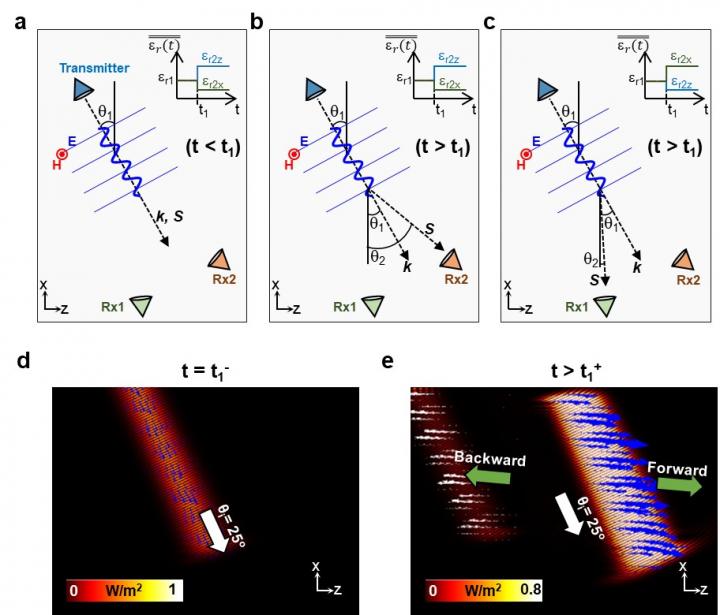
Credit: by Victor Pacheco-Peña and Nader Engheta
Tailoring and manipulating electromagnetic wave propagation has been of great interest within the scientific community for many decades. In this context, wave propagation have been engineered by properly introducing spatial inhomogeneities along the path where the wave is traveling. Antennas and communications systems in general have greatly benefited from this wave-matter control. For instance, if one needs to re-direct the radiated field (information) from an antenna (transmitter) to a desired direction and reach a receiving antenna placed at a different location, one can simply place the former in a translation stage and mechanically steer the propagation of the emitted electromagnetic wave. Such beam steering techniques have greatly contributed to the spatial aiming of targets in applications such as radars and point-to-point communication systems. The beam steering can also be achieved using metamaterials and metasurfaces by means of spatially controlling the effective electromagnetic parameters of a designed meta-lens antenna system and/or using reconfigurable meta-surfaces. The next question to ask: could we push the limits of current beam steering applications by controlling electromagnetic properties of media not only in space but also in time (i.e., 4D metamaterials x,y,z,t)? In order words, would it be possible to achieve temporal aiming of electromagnetic waves?
In a new paper published in Light Science & Application, Victor Pacheco-Peña from the School of Mathematics, Statistics and Physics of Newcastle University in UK and Nader Engheta from and Department of Electrical and Systems Engineering of the University of Pennsylvania, USA have answered this question by proposing the idea of temporal metamaterials that change from an isotropic to an anisotropic permittivity tensor. In this concept, the authors consider a rapid change of the permittivity of the whole medium where the wave is traveling and demonstrated both numerically and analytically the effects of such a temporal boundary caused by the rapid temporal change of permittivity. In so doing, forward and backward waves are produced with wave vector k preserved through the whole process while frequency is changed, depending on the values of the permittivity tensor before and after the temporal change of permittivity.
Interestingly, the authors’ theoretical results also show how the direction of the energy propagation (defined by the Poynting vector S) is different from that of the wave number, leading to real-time beam steering of electromagnetic energy, a phenomenon the authors named Temporal aiming as the temporal analogue of the spatial beaming. All the reported numerical calculations are in excellent agreement with analytical calculations. As the authors comment:
“In this study we provide an in-depth analysis of the underlying physics behind such temporal aiming approach achieved by rapidly changing the permittivity of the medium containing the wave, from isotropic to anisotropic values. As an exciting result, we were able to extract a closed analytical and simple formula for the new direction of energy propagation of the already present electromagnetic wave.”
“We present a detailed study considering monochromatic waves under different oblique incident angles along with more complex incident electromagnetic waves such as Gaussian beams.”
“Since this temporal aiming allows us to arbitrarily change the direction of energy propagation in real time, it could open new possibilities for real time beam steering. We provide a numerical example of a single transmitter antenna and three receivers placed at different spatial locations. Our example demonstrates how the transmitted electromagnetic wave can reach any of the three receivers by simply engineering a time-dependent permittivity of the medium following a square function: isotropic – anisotropic – isotropic”.
“The presented technique has the potential to open new possibilities for the routing of information in integrated photonic systems by implementing temporal metamaterials that can deflect the guided electromagnetic waves to a desired target/direction on a chip” the scientists forecast.
###
Media Contact
Victor Pacheco-Peña
[email protected]
Related Journal Article
http://dx.




